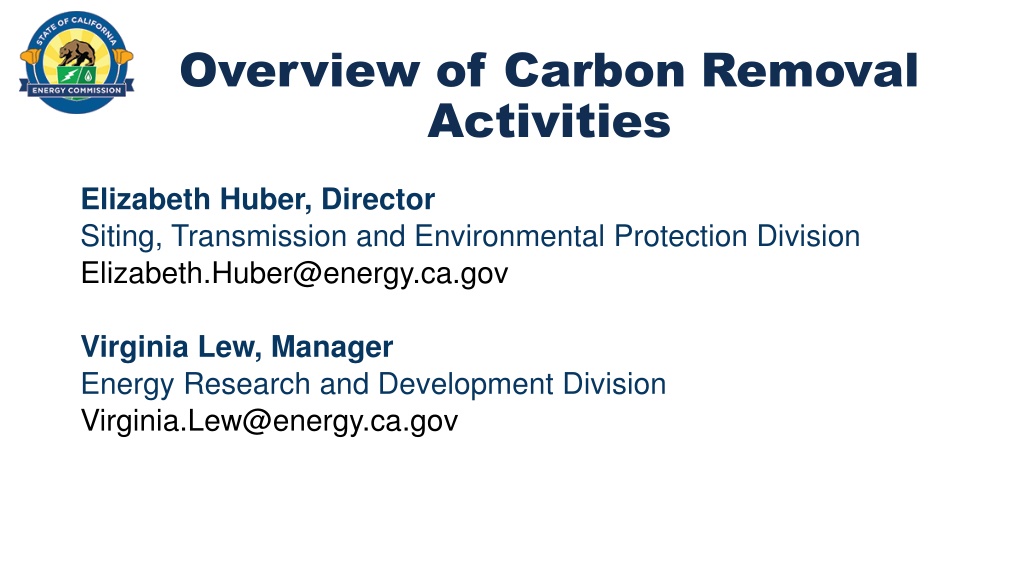Overview of California's Carbon Removal Initiatives
California's Carbon Removal Innovation Support Program (CRISP) aims to incentivize Direct Air Capture (DAC) development in the state. The program includes research test centers, small-scale demonstrations of DAC technologies, community engagement, technical assistance, and more to enhance carbon removal efforts. Additionally, post-certification changes to CEC Jurisdictional Power highlight projects like the Sutter Energy Center and Los Medanos Energy Center's carbon capture and storage initiatives. These initiatives reflect California's commitment to advancing carbon removal technologies and combating climate change.
Download Presentation

Please find below an Image/Link to download the presentation.
The content on the website is provided AS IS for your information and personal use only. It may not be sold, licensed, or shared on other websites without obtaining consent from the author. Download presentation by click this link. If you encounter any issues during the download, it is possible that the publisher has removed the file from their server.
E N D
Presentation Transcript
Overview of Carbon Removal Activities Elizabeth Huber, Director Siting, Transmission and Environmental Protection Division Elizabeth.Huber@energy.ca.gov Virginia Lew, Manager Energy Research and Development Division Virginia.Lew@energy.ca.gov
Carbon Removal Innovation Support Program (CRISP) AB 209 (The Energy and Climate Change budget bill, Chapter 251, Statutes of 2022) mandated a program to incentivize Direct Air Capture (DAC) development in California Tentative Schedule Tentative Program Elements Research Test Center* - facilitate pilot testing of DAC technologies Summer 2023 DAC technologies include mechanical and chemical processes that capture atmospheric carbon dioxide as opposed to point- source carbon capture Released Cost Share for Federal Grants Small Scale Demonstrations of DAC Technologies Late 2023 Community Engagement and Outreach - facilitate education and community needs Late 2023 On-going TechnicalAssistance &Admin TOTAL $75M * Options considered: Building center in California Grants or vouchers for tech providers to test at existing test facilities (NETL) CRISP Web Link
Post Certification Changes to CEC Jurisdictional Power The Siting, Transmission and Environmental Protection (STEP) Division licenses a power plant 50 MW or more, the project must comply with all provisions of their CEC license. Per California Code of Regulations Section 1769, if there are any proposed changes to the design, operation, or performance of a licensed project then the CEC must approve that project change before construction can begin. STEP s environmental review is a functional equivalent to CEQA s (California Environmental Quality Act) environmental impact report.
Post Certification Changes to CEC Jurisdictional Power Power Plant Post Certification Petition Approved Sutter Energy Center Post combustion carbon capture and storage project. Carbon dioxide will be collected in a first-in-the-world air- cooled capture facility, transported, and permanently sequestered in a geological storage location. Pending Los Medanos Energy Center October 2022 Demonstration project to test a solvent technology to capture carbon dioxide from a small portion of flue gas from a single turbine exhaust at the power plant. Los Medanos Energy Center Installation of a flue gas pipe for use in an offsite demonstration project that is manufacturing carbon dioxide sequestration upcycled rock products. May 2022
Resources Carbon Removal Innovation Support Program: CRISP Los Medanos Energy Center (98-AFC-01C): Los Medanos Energy Center Sutter Energy Center (97-AFC-02C): Sutter Energy Center

























